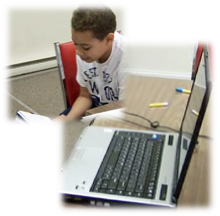Engaging 21st Century Learners
- Introduction: Engaging Learners
- 21st century Tools
2. 21st Century Tools
In a 21st century world of competition and innovation that doubles by the minute, our own students might just be out-pacing us in their use of technology. How do we know then that they’re using it effectively, applying smart research strategy, avoiding copyright issues, citing and using evidence to support new and old ideas? Unless we teach them how, odds are they probably  will not. The key is to engage them with what they’re familiar with, comfortable in, and what will grab and keep their attention. The studies we’ll review in this course will overview what student engagement looks inside and outside of technology, the classroom successes and challenges in using 21st century technologies, what it looks like in the classroom and most important: what students have to say about their own engagement.
will not. The key is to engage them with what they’re familiar with, comfortable in, and what will grab and keep their attention. The studies we’ll review in this course will overview what student engagement looks inside and outside of technology, the classroom successes and challenges in using 21st century technologies, what it looks like in the classroom and most important: what students have to say about their own engagement.
The American Association of School Librarians and other associations have set forth learning standards 21st century learning, lifelong personal growth, and enjoyment. They are as follows:
Learners use skills, resources and tools to:
- Inquire, think critically, and gain knowledge.
- Draw conclusions, make informed decisions, apply knowledge to new situations, and create new knowledge.
- Share knowledge and participate ethically and productively as members of our democratic society.
- Pursue personal and aesthetic growth.
The Common Core Standards require that students have “collaborative discussions”, problem solve and communicate as peers, “integrate technical information” to include comparing and contrasting information from multimedia.
The National Educational Technology Standards(NETS) evaluate what students need to know in, and about, a digital world to become effective learners and live productively within it. They set forth that students must work creatively and with innovation; communicate and collaborate; research with information fluency; think critically; problem-solve and make decisions. It is important that classroom teachers acquaint themselves with the performance levels and cognitive abilities of all students in their class.
All of these expectations inform classrooms rife with the tools and resources that work into high student engagement and rigorous learning paths that build student capacity for learning and working independently.
Easier said than done, because it’s about a recursive cycle of planning, monitoring and adjusting instruction, and using the tools that work into the interests of the 21st century learner. As learners in this course we’ll read about first-hand studies that have worked 21st century learning into classrooms through Internet-based technologies, handheld devices, and yes - PCs. Along with getting introduced to some new and some not-so-new 21st century tools, we’ll review and analyze strategy, strategy guides, lesson plans and video classroom demonstration of 21st century learning in action. Finally, we will use the strategies and tools gleaned from this course by importing them into new units and lessons to create our own standards-aligned 21st century learning plans.
Here are a few ideas to begin with:
- Use of Skype to connect and communicate with others over the Internet.
- Use of iPads for hybrid classroom instruction.
- Google Earth for geography and cultural lessons.
- Online math games using gaming apps.
- Presenting Discovery (and other) lessons using Smartboard.
- Virtual field trips using Smartboard, iPads or laptops.
- Maintaining a classroom blog for publication of student work and archiving of artwork and stories shared with parents and peers.
- Use of free online resources include lessons, quizmakers, rubric makers, graphic organizers and strategy guides. Depending on the type of disability, these methods may help compensate or remediate processing deficits that prevent students with disabilities from benefiting from traditional instructional techniques.
Let’s talk about the strategies and tools used in our classrooms to date, and how we might use these and other ideas in the future. Most important, let’s discuss what our own goals are for this course in the discussion forum that follows.
Onward and upward,